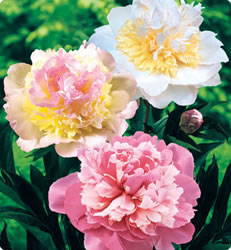Multiply By Dividing: Divide Perennials For More Plants & Healthier Growth
Perennial plants are terrific - plant them once, feed and
water them regularly and they offer flowers, fruit and foliage for years. There
comes a time, though, when many perennials start to look a little puny. If your
perennial starts to fade out - the flowers are small, sparse and the body of
the plant looks like a size 8 foot shoved into a size 4 shoe - it is probably
time to dig, divide and replant.
Peony Trio - Fragrant, hardy peonies for your garden. Edulis Superba, Top Brass and Raspberry Sundae varieties.

Not all perennials can be divided. Woody perennials, such
as roses, mockorange or hydrangea, have a root system
that needs to stay intact for optimal growth. Judicious pruning and cloning by
way of cuttings rather than divisions would help to rejuvenate and duplicate
these plants. Plants with fibrous or multibranched root systems, each branch
sending up one or more flowering stalks, are the best candidates for
division. These plants include peonies,
iris, ornamental grasses, ferns, monarda, mints, chives, hostas
and daylilies.
The tools needed to divide plants are fairly basic: a
durable, sharp spade and a utility knife will do the job nicely. Large clumps of ornamental grass may also
require a Sawzall that will slice through the tangle
of roots and soil.
Doing divisions looks brutal, and is similar to doing
surgery on the plant. First, use a
garden fork or spade to loosen the plant from the soil. Next, plunge the spade
into the heart of the plant. Press the blade down so that it cuts completely
through the plant's roots, and rock gently back and forth. This should create a
clear schism, and rocking will leverage one half of the plant out of the
ground. Use the utility knife to cut
through any conjoined roots and separate the plant completely. If the plant is extremely large, the halves
can be halved again, creating 4 plants from one. Keep as much of the root ball
intact as possible, but tease apart roots that are girdled. Trim off any blooms and replant the divisions
into well-prepared soil. Water the new
plants in, and keep them watered and protected from strong winds until new
roots develop and anchor the plants in the ground. This should take about four
to six weeks.
Daylilies and iris divide themselves naturally. Both
daylilies and iris send up fans, or leaf clusters attached to a fingerlike
root. Use the same method described above to separate the fans daylily and iris
plants produce. After division, trim the foliage of the fan down to a length of
3", replant at the same depth at which the original plant was positioned,
and water in.
The best seasons in which to divide plants are early spring
and late summer through fall, from August through November. Fall divisions need
to be watered consistently until the first heavy frost hits. Roots grow, albeit
slowly, in late fall until the ground freezes and the plant is completely
dormant. What are the rewards for these efforts? Both the original plant and the divisions
will show greater vigor and send out more blooms per plant., plant divisions
are exact duplicates of their parent plant so one favorite plant can be
replicated throughout the garden, and the cost to expand the garden is time and
effort rather than dollars and cents.